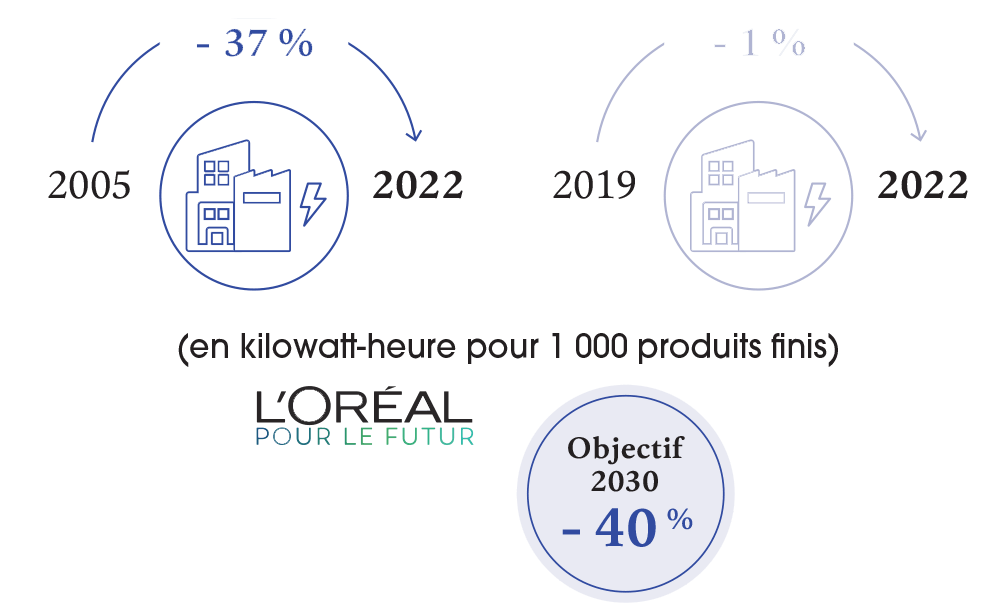
At the end of 2022, 65% of the Group’s sites were “carbon neutral”.

4.3.1.1.4. Preserving water resources on operated sites
L’Oréal Group aspires to preserve water resources throughout its value chain, especially on each site operated. The action plans implemented around the world are based notably on the following key principles:
- mapping the volumes of water used, particularly by the Group’s factories, using a L’Oréal internal tool that carries out a comprehensive analysis of the various uses of water on a site: the Waters can tool. Each type of use is quantified and compared with a benchmark value in order to identify potential reductions;
- the installation of reduction equipment and processes. This particularly concerns the cleaning phase of production equipment and factory filling and packing lines, following the OPTICIP (OPTImisation Cleaning In Place) approach developed by L’Oréal; and
- the reuse of untreated industrial water for a new purpose and recycling of the water used, after a specific additional treatment step.
At the end of 2022, 16 Group factories had these recycling facilities and were able to reuse water in industrial processes.
The L’Oréal for the Future programme has set the following objective for 2030: 100% of the water used in industrial processes will be recycled and reused in a loop, i.e. 100%of factories will be Waterloop factories.

At the end of 2022, 5 factories were awarded the status of Waterloop Factory, i.e. 13% ☑ of the Group’s factories.

☑ The Statutory Auditors have expressed reasonable assurance with regard to this indicator.
The “Waterloop Factory” concept
The Waterloop Factory concept consists of using city mains water only for human consumption and for the production of the high-quality water used as a raw material for product processing. This means that the water required by the utilities (cleaning equipment, steam production, etc.)is derived from water that is reused or recycled in a loop on the site.
It involves the implementation of a two-step system:
- the optimisation of industrial processes in order to minimise water used which leads to a reduction of water withdrawals; and
- the installation of a water recycling system: industrial wastewater undergoes pre-treatment in the on-site treatment plant. It is then reprocessed using various technologies (ultrafiltration, reverse osmosis, nanofiltration, etc.) in order to extract very high-quality water. This water is then used in a loop to clean production tools, and for utilities as a replacement for municipal water. As such, water requirements for utilities are fully covered.
The Waterloop Factory concept was adopted for the first time in 2017 by the Burgos factory in Spain. In 2022, this concept was also extended to the factories in Settimo in Italy, Vorsino in Russia, Libramont in Belgium and Yichangin China. It will gradually be deployed to all Group factories according to a priorization based on the local water stress situation.
Water withdrawal at industrial sites
As part of the L’Oréal for the Future programme, the Group has set itself the target for 2030 of reducing the water withdrawal at factories and distribution centres per unit of finished product by 30% compared with 2019.
Total water withdrawal at the industrial sites came to 2,152 thousand m3 ☑ in 2022, down 1% compared with 2019,while the production of finished products increased by 5% over the same period. Water withdrawal was 0.33 litres per finished product in 2022 ☑, representing a decrease of 6% from 2019 (and a decrease of 1% from 2021).

This diagram shows the water withdrawal at industrial sites
From 2005 to 2022: - 54%
From 2019 to 2022: - 6 %
L’Oréal pour le futur - Target 2030 : - 30%
This diagram shows the water withdrawal at industrial sites
☑ The Statutory Auditors have expressed reasonable assurance about this indicator.
